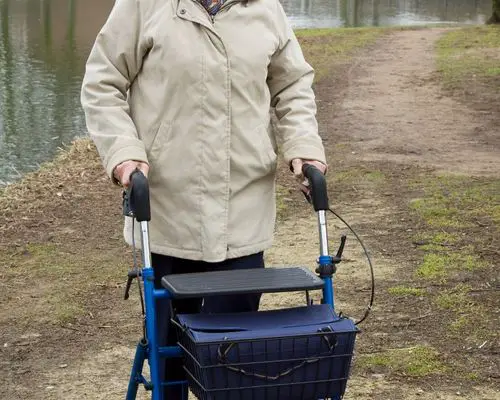For anyone with mobility issues, a walking aid can be a life changing piece of equipment. The great news is that there are plenty of different types of walking aids to choose from, so you’ll always find something that closely meets your needs. The bad news is that this vast choice can leave buyers feeling confused.
The great debate between walker vs rollator leaves people scratching their heads over which might help them better. In truth, both of these pieces of equipment are very similar but they do suit people with different needs.
A walker is a metal frame that the user lifts and places in front of them as they move to help with stability and balance. A rollator is very similar in design in that it is a frame but instead of legs, it has wheels. This eliminates the need to lift the device with each step but still provides the user with additional balance.
Deciding which to get doesn’t need to be confusing. In fact, there are some key points that will help you make the best decision. In this short guide, I’ll discuss everything you need to know.
What Is A Walker?
Walkers are a commonly used mobility aid that consist of a metal frame with four legs. This piece of equipment is used for people who need a little extra support with balance when they are walking. You’ve probably heard of the zimmer frame; that’s a type of walker and is a name that many people use to describe these devices.
Walkers require the user to lift the frame up and move it forward as they take each step. This means that anyone using a walker must have adequate strength to lift the frame, albeit they’re not very heavy. Moreover, it’s essential that grip strength is sufficient when lifting and placing the frame back down.
A walker offers some support for your body and there are accessories such as bags that you can buy to make using your walker easier. However, it’s important to keep in mind that these devices are just a frame and do not have a seat, which is one of the key differences between a walker and a rollator.
What Is A Rollator?
Rollators are different to walkers in one very obvious way; they have wheels instead of just legs. You might hear people calling these rolling walkers and they’re ideal for people who aren’t able to lift the frame as they take each step. You simply push them along.
While a rollator also features a frame, it’s slightly different to that of a walker in that there is usually an incorporated seat.
Owing to the design of the rollator and the fact that it has wheels, it is not a device suitable for those who are looking for support with their balance or body weight. But those wheels do make them very easy to move around.
What’s The Difference Between A Rollator And A Walker?
Having looked at the designs of the rollator and the walker, it’s clear to see that there are some obvious differences, despite also being similar in many ways.
When using a walker, the legs will remain in contact with the floor when you take a step. Before taking your next step, you must lift the walker and place it back down, a little further ahead. On the other hand, a rollator’s wheels stay in contact with the ground at all times and the frame is never lifted.
Rollators tend to be a lot easier to move since they have swiveling wheels so they’re commonly used inside the house, especially in smaller properties like flats and apartments.
With a walker, you’ll notice that they are a little more clunky and difficult to move around but they offer far superior support in terms of balance of body weight.
Do I Need A Walker Or A Rollator?
If you have mobility issues then a walker or a rollator could make a huge difference to your life in terms of independence. However, it’s vital to choose the right one to ensure it offers the right kind of assistance and to ensure your safety.
For people that have any kind of balance issues or weakness when on their feet, a rollator will not be suitable. It cannot offer the type of firm support you’ll need when walking whereas a walker will.
However, for people who are a little more steady on their feet and don’t require balance support, a rollator is a good choice. They’re suitable for people who may need to rest frequently as the built in seat allows you to stop and sit when you need to. Moreover, if you have heavy equipment such as an oxygen tank, your rollator can accommodate this.
Anyone who has weakness in the upper body or arms may find it difficult to use a walker. In this case, a rollator would be the most sensible option. If you opt to use a walker then you’ll need to lift it before you take each step; it only needs to be moved forward as far as your arms can stretch but it’s important that you’re comfortable doing this.
Factors To Consider When Choosing Between A Walker And A Rollator
You can see from the advice above that a rollator and a walker suit people with different needs. It’s important to take a few factors into consideration when choosing between these pieces of equipment. Safety should always be your number one concern but there are some other practical aspects worth mentioning.
First of all, consider where you will be using the equipment. If you often go out of the home then you’re going to need a rollator or walker that can be easily transported. For example, does it collapse so you can put it in the boot of your car?
Also make sure that, when choosing your equipment, you are properly measured for it. Your height will play an important role in getting a walker or rollator that is comfortable for you to use. On top of this, many products also come with a weight capacity. While this can be a difficult subject for some, it’s vital that you choose something compatible with your weight for your own safety.
Finally, think about your budget. While I would never recommend buying a cheap piece of equipment just to save money, everyone has a limit on what they can afford to spend. The best advice is to buy the best piece of equipment you can afford and don’t be afraid to shop around. Consider all the features of the walker or rollator before making a final decision.
A Note On Hybrids
It’s worth mentioning that there are hybrid walker/rollators which have legs at the back and wheels on the front. These rolling walkers are used by lifting the frame and resting your weight on the wheels to move forward.
They’re great for people who need a limited amount of balance support and in enclosed spaces. However, do keep in mind that this type of walker doesn’t usually come with a built in seat which can be a deal breaker for some users.
Conclusion
Choosing the right piece of mobility equipment can be the difference between greater independence and struggling to get around. Walkers and rollators may appear similar at first glance and, in some ways, they are.
The main difference between them is the presence of wheels and this affects the suitability of the device for certain users. For example, if you have balance problems then a wheeled rollator is not going to be as safe as a firm walker.

